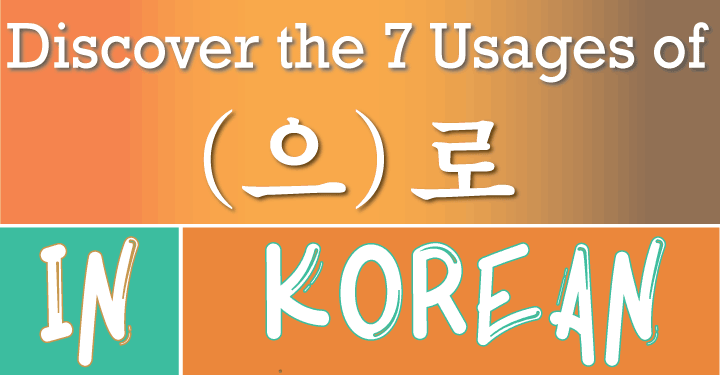Discover the 7 Usages of (으)로 in Korean
This lesson will teach you the seven different usages for (으)로 in Korean. (으)로 is quite the versatile Korean particle and it’s grammar structure is fairly easy.
Korean Particle (으)로 Grammar Structure
- Noun Ending in Consonant + 으로
펜 + 으로 = 펜으로 - Noun Ending in Vowel + 로
한국어 + 로 = 한국어로 - Noun Ending in ㄹ + 로
신발 + 로 = 신발로
The 7 Uses of the Korean Particle (으)로
1. By Means of, By, With
You may express “By,” “By means of,” or “With.” using (으)로 in Korean. You attach (으)로 to a tool, vehicle, instrument, or other item that you use.
| Korean | English |
| 저는 펜으로 서명했어요. | I signed with a pen. |
| 학생은 학교에 자전거로 갔어요. | The student went to school by bike. |
| 저는 그 의자를 손으로 만들었어요. | I made that chair by hand. |
2. To, Toward
You may express “To” or “Toward” a general direction using (으)로 in Korean. You attach (으)로 to a noun to express what direction something happens in.
에 vs (으)로
에 also means “To” but 에 is to a specific destination while (으)로 is toward a general direction.
집에 가요? = Are you going home?
집으로 가요? = Are you going toward home?
You can often use sentences like these interchangeably. Other times the difference between “To a specific destination” and “Toward a location” matters.
| Korean | English |
| 오른쪽으로 오세요. | Come toward the right side. |
| 학교 쪽으로 가세요. | Go toward school. |
| 어디로 가요? | Where are you going toward? |
3. Language
You may express what language you use to speak in with (으)로 in Korean. You attach (으)로 to the language that you use.
| Korean | English |
| 저는 중국어로 말했어요. | I said it in Chinese. |
| 저는 그 문장을 영어로 말했어요. | I said that sentence in English. |
| 일본어로 말씀해 주세요. | Speak in Japanese please. |
4. A Choice Among Many Options
You may express that something is chosen from many options with (으)로 in Korean. You attach (으)로 to the chosen option, noun.
Waiter: 무슨 맛으로 드릴까요? = What flavor would you like?
Guest 1: 딸기 맛으로 주세요. = Give me strawberry flavor please.
Guest 2: 오렌지 맛으로 주세요. = Give me orange flavor please.
5. Transformation or Change
You may express that something has transformed or changed with (으)로 in Korean. You attach (으)로 to the resultant noun.
| Korean | English |
| 비가 눈으로 변했어요. | The rain changed into snow. |
| 탐이 부장님으로 고용됐어요. | Tom was hired as the manager. |
| 혜란이가 예쁜 여자로 자랐어요. | Hyeran grew up to be a pretty woman. |
6. Cause or Reason for a Result
You may express a cause or reason for a result with (으)로 in Korean. You attach (으)로 to the cause or reason for the result.
| Korean | English |
| 김연아가 올림픽으로 유명해 졌어요. | Kim Yuna became famous because of the Olympics. |
| 싸이가 Gangnam Style로 유명해 졌어요. | PSY became famous because of “Gangnam Style.” |
7. Ordinals and Telling the Order
You may express the order in which something happened with (으)로 in Korean. You attach (으)로 to an ordinal.
| Korean | English |
| 저는 두 번째로 집에 갔어요. | I went home second. |
| 저는 첫 번째로 먹을 거예요. | I will eat first. |
[rad_rapidology_inline optin_id=”optin_1″]


Leave a Reply
You must be logged in to post a comment.